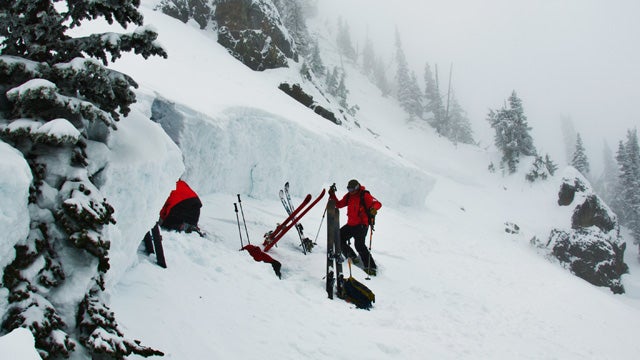You and your ski partner just crested the summit of your favorite backcountry slope. The snow glistens in the untracked bowl below. She drops in and carves a large arcing turn. You watch, horrified, as the snow fractures around her, transforming her tracks into a pixelated white abyss, swallowing her in a powdery torrent. Just like that, she’s gone.
Last season, 24 people died in avalanches in North America. Most of these accidents could have been avoided. If you plan to venture into the backcountry this season, improve your odds with an avalanche course.
Consider an alternate scenario: You and your partner stand at the top of the slope and discuss the snowpack. She repeats the danger rating from the local avalanche center. Today is moderate, going to considerable. The sun’s warmth is weakening the snowpack and you both acknowledge the growing danger. You stand on the ridge a safe distance from an overhanging cornice. The slope below rolls over and steepens. Your snow profile pit gives you pause. A solid slab sits above a weak layer: the perfect ingredients for an avalanche. You choose a safer, lower angle slope. At the trailhead, you high-five each other, promising to return when the snowpack improves.
Avalanche education won’t protect you from avalanches but it can provide tools to assess the hazard, gain experience, and learn to make sound judgment.
Where To Start
There are two main organizations that offer avalanche education in the U.S. The American Avalanche Association is a non-profit that avalanche education and safety. It certifies avalanche instructors and offers education guidelines. Certified instructors are vetted by the AAA and reviewed by professional members. They offer classes ranging very basic “avalanche awareness” courses to those designed for professionals. The provides links to avalanche schools, educators and avalanche centers throughout the nation. AAA does not offer instructor training.
The American Institute for Avalanche Research and Education (AIARE) offers both classes and instructor training. Their curriculum is based on the AAA guidelines. AIARE , including products and materials. When you sign up for an avi class look for it to designate that it’s AIARE or AAA certified.
What to Look for In a Level-1 Avalanche Course
Anyone regularly traveling in avalanche terrain should consider a Level 1 course. The course should cover the different types of avalanches, basic slab mechanics, terrain evaluation and travel protocols, snowpack and weather, as well as decision-making tools, and rescue skills. This is a 24-hour course and at least 60 percent of the time will be spent in the field. Students should emerge with a solid foundation of skills and the ability to venture into the backcountry and continue to gather information and gain judgment.��
A good avalanche course should encourage communication and actively teach decision-making tools. A Level 1 course should also cover rescue skills and transceiver use. You should learn how to find multiple buried beacons and learn searching techniques for those not wearing transceivers.
Further Study
If you want more, the Level 2 course is intended for backcountry leaders and those wanting to further build their skills. The Level 3 is for advanced recreationists and professionals. The AV Pro class includes advanced professional avalanche training designed for avalanche workers.
Schools by Region
Pacific Northwest: Northwest Avalanche Institute in partnership with International Mountain Guides offers for backcountry skiers, climbers and professionals. All courses meet or exceed the AAA guidelines Enumclaw, WA 360-825-9261
Colorado: is one of the oldest and most respected avalanche schools in the nation. Their courses meet the AAA guidelines and they are an AIARE course provider. Silverton, CO 970-903-7039
��
Intermountain: operates in several locations in the United States. All of their instructors are professional AAA members and many are certified members with extensive experience. AAI’s Level 2 and Level 3 courses are recognized by the American Mountain Guides Association. Victor, ID (307) 733-3315
��
California: offers Level 1, 2 and 3 AIARE courses lead by AAA certified instructors. Truckee, CA 530-582-9170
��
Alaska: was founded in 1976 by avalanche experts Doug Fesler and Jill Fredston. Today, AAS employs excellent instructors, many of whom are certified members of AAA. Anchorage, AK 907.345.0878

